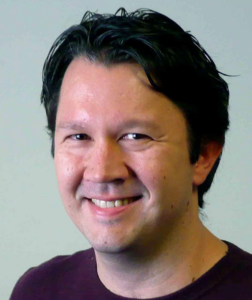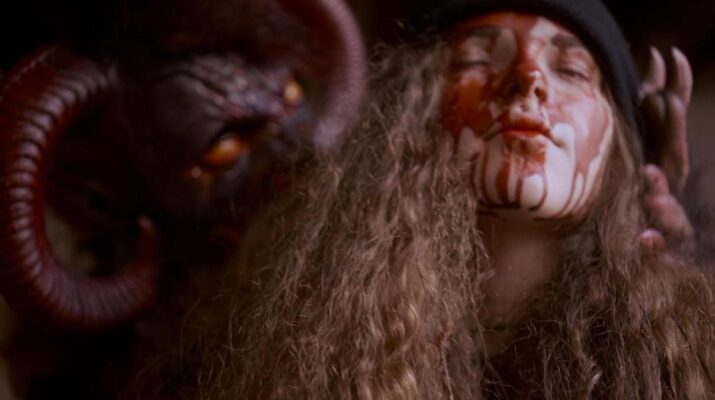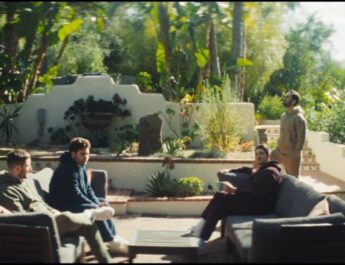From cult directors Brad Sykes (Plaguers, Scream Queen), Todd Sheets (Goblin, Bonehill Road), Anthony Catanese (Sodomaniac, Girls Just Wanna Have Blood) and Tim Ritter (Truth or Dare, Killing Spree) comes the highly-anticipated final film in the cult hit ‘Hi-‘ trilogy, preceded by Hi-8 (2013) and Hi-Death (2018), HI-FEAR – on Digital June 13 and DVD July 11 from Wild Eye Releasing.
We spoke to veteran genre filmmaker Sykes and producing partner Josephina Sykes (Plaguers, Camp Blood, Evil Sister 2) about the fantastic horror threequel.

-So HI-FEAR is being billed as the final film in the series – how true is that? if the film makes a pretty penny, will you consider going again?
BRAD SYKES: There are no plan at the moment to make any more films in the ‘HI’ series after HI-FEAR. We honestly never thought we’d end up making a trilogy, as the first movie, HI-8, was more of an experimental project that we did more for fun than anything else. Josephina and I continued making these films because we enjoyed working with certain filmmakers, like Tim Ritter, Todd Sheets and Tony Catanese, and because we kept coming up with ideas that were ideal for the short film format. But we want to go out on a high note with HI-FEAR, and now we are focusing more on our next feature which, like the ‘HI’ films, will stretch the genre in new directions.
-How long ago did you start work on HI-FEAR?
JOSEPHINA SYKES: HI-FEAR started in 2019 with 3 segments out 4 in the can and the production process was almost as fast and prolific as it was in our first anthology, “HI-8”. In 2019, we had smooth sailing with director Todd Sheets’ segment “Losing It At The Devil’s Whorehouse” (a fun ‘80s-inspired horror comedy with lots of gore) that completely finished and delivered to us. In the same year, Tom Ritter shot “When Shadows Come Alive” in Kentucky, a complex cannibal story in the woods intertwined with a parody of a killer priest. In 2019 we also wrapped filming on “Day Out of Days”, that we co-wrote and directed by Brad, in the remote mountain town of Frazier Park, an hour and a half away from Los Angeles. It’s a sci-fi story of a film crew caught up in a middle of a climate change crisis caused by alien invasion. We were finishing editing when the pandemic started.
-And does the finished product resemble that original template and treatment for the film?
BS: It does! Despite the pandemic and other hurdles, this was actually a smoother production overall than the previous film, HI-DEATH. On HI-FEAR, we shot all the segments that were planned and they all came out well. I’m especially proud of the wraparound on HI-FEAR, which has a cool comic book theme that was complicated to pull off but totally worth it.
-What makes a good anthology, in your opinion? And what do you think HI-FEAR encompasses that, say, some of the others in the sub-genre might not?
BS: I think a good anthology should offer up different types of horror while at the same time having a unified vision or theme. That’s why, with each of these films, we’ve always had a ‘theme’: on HI-8, the idea was for everyone to return to their roots and make low tech shorts like they did when starting out. With HI-DEATH, each filmmaker addressed the theme of death in their own way. And now with HI-FEAR, each director deals with their greatest fear.
At the same time, all the segments are radically different in style and tone – and they’re shot all over the US, so they represent different environments, too. Also, all the segment directors are better known for feature films, so their segments are treated like mini-movies. I think that gives the ‘HI’ films an edge over other horror anthologies.
-What do you believe your respective strengths as filmmakers are? Does one of you, for instance, excel in one area over the other?
BS: That’s one of the things Josephina and I considered from the first film, bringing together directors whose styles and content are different from one another, so there will be a good mix. Like I mentioned before, the directors on the ‘HI’ films are veteran feature filmmakers with filmographies that in some cases go back to the 1980s, so one can get a feel for their strengths by watching their work over the years.
If I had to generalize, I would say that Todd Sheets (BONEHILL ROAD) goes for a more comic book-grindhouse style with extreme situations and gore. Tim Ritter (KILLING SPREE) is darker, more psychological and usually has some kind of sexual or relationship dynamic at the core of the story. Anthony Catanese (SODOMANIAC) specializes in gritty urban films with a punk rock style. And my films (which include CAMP BLOOD and SCREAM QUEEN) often have strong female leads and tend to be self-reflexive – all three segments I’ve done for the ‘HI’ films have filmmaking themes. So, there’s a nice variety of content and style in each film.
That said, part of the fun of the ‘HI’ films is also watching some of these directors deviate from their usual style or storylines – it’s been a nice surprise for us and for the fans, too.
-And do you always get along?
JS: It is a dream come true for Brad and I to work together since we met on a film set in Romania years ago. We are both creative and like-minded spirits. We communicate well with each other, updating one another with what is new. Most importantly, we are always on the same page with what kind of movie we are making: from the tone, references, budget, concept, cast, story, visual style, everything. We each have the same movie in our heads, there is no misunderstanding. And that is the most important thing since it happened to Brad many times in the past to deal with producers that thought they were making another movie than what they discussed with Brad and they were many issues on set caused by this rift.
That doesn’t mean we never disagree, or we don’t have different ideas of how to do a certain thing. In time, we learnt how to communicate our ideas better and avoid a fight if possible. In the past, even our fights came from passion and care, from a good place, but still, it isn’t productive. In life and filmmaking you learn all the time and we know that each other wants the best for the movie so we learnt to listen to each other better, discuss issues, sleep on them, think of the other’s idea, and not rush to conclusions fast. Try to understand the other person’s point of view and decide what is best for the movie. As usual, you need to put your ego aside and put the movie first. It’s not about who is right or wrong, that isn’t valid, it is about what is the best for that particular movie under the circumstances you deal with at that moment. It is easier for everyone we work with to know we have the same vision. We both want to make the best movie possible. And we have each other back’s all the time!
-Did things slow down for you during the pandemic?
JS: Yes! We had no breaks on HI-FEAR but had to deal with delays and obstacles from our VFX artist who got very busy during the pandemic with more work than usual (due to long distance work everyone needed more VFX shots in their projects). It took longer to finish our shots on our segment “Day out of Days” since we are indies and our budgets are lower and he pushed our movie to finish other paying gigs, to some of our team members lost their parents due to Covid which was terrible. Also, people we work with got sick with the virus along the way so you worry about them.
Also, from a production point of view, our 4th segment wasn’t filmed till February 2021 when director Anthony Catanese was able to shoot in New Jersey when the state had less cases. We wanted to wait for him because he is very talented and he was on board from the beginning, we liked the segment he created for HI-DEATH and loved the script he wrote for HI-FEAR called “The Streets are Watching”, an urban tale with a hellish ending as gritty as any Abel Ferrara movie.
We usually shoot the wraparound on our horror anthologies (HI-FEAR is the 3rd installment after HI-8 and HI-DEATH, we have a trilogy here!) last after everyone finished their segments so that we can see them and create a link between them and this connecting piece. In this case, since Anthony couldn’t shoot his segment yet, we filmed the wraparound first, in November 2020 between lockdowns.
Initially, we wanted to shoot it in downtown Los Angeles with extras with Special FX Make-up. During 2020 we changed the script around locations in North Hollywood where we live with other urban spaces in the city, outdoors for safety. It was easier for us to do more 2nd unit shots ourselves (the principal photography was done in 1 day), so we can go out anytime we needed, which we kept doing for a few days with no crew. We also used VFX instead of practical FX Make-up, which we prefer but it was safer to go with VFX. No extras, just whoever was passing by and Brad and I playing joggers and got VFX added to us later on. So, a bit of fun trivia, you will see us in the movie, even if we prefer being behind the cameras.
We found a safe way to shoot the story of a female comic book artist creating four terrifying tales (an homage to CREEPSHOW) without changing or compromising our vision. We created comic book pages as transitions between segments. We even had made an actual comic book as a prop for the movie.
As indie filmmakers we are used with various challenges getting thrown at us so we got creative and made it work well! By early 2022, HI-FEAR was completed and started the festival circuit and now it’s released on DVD and Digital by Wild Eye Releasing! So, we hope you will give it a watch if you want to see a true indie movie, original, lacking clichés with various type of horror that will scare you and entertain you!


